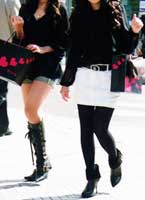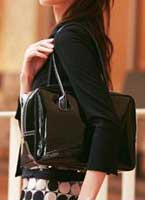|
FASHIONABLY BLACK
Contrasting Fabrics Lend a New Twist to Boom
(November 9, 2007)
|
|
Black satin trench coats, black dresses embellished with black sequins, black enamel bags and boots, and other black-dominated items are gracing boutique and department store windows this autumn. Around town, black is enjoying growing popularity as the color of choice for blouses, dresses, tight pants, fedora hats, shawls, boots, bags, and other items. In the past, black was used in combination with white for a monotone look or as a backdrop for a brightly colored item. This season, however, all-black outfits are a common sight as fashionable young women combine black items of different textures and materials. The Rise of Black In the 1990s, the Amekaji style rooted in American casual wear gained ground among the young people who gathered in Center-gai, Shibuya's main shopping street. The tendency to dress from head to toe in DC-label clothes gave way to a new look characterized by a combination of imported items of different colors purchased from specialty boutiques. This pushed up demand for black as people discovered it could be worn with an array of colors. By the 1990s, black was a standard hue in people's wardrobes. Black in the Driving Seat All-black outfits run the risk of looking uninspired and somber, but this season fans of black are increasingly creating distinctive looks by combining black items made from a variety of materials, such as satin, knit, leather, fur, suede, enamel, cotton, and wool. Creating an effect not with colors but with subtly different materials and textures is a key to the fashion scene this autumn. |
Copyright (C)2007 Web Japan. Edited by Japan Echo Inc. based on domestic Japanese news sources. Articles presented here are offered for reference purposes and do not necessarily represent the policy or views of the Japanese Government.


